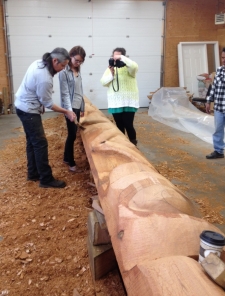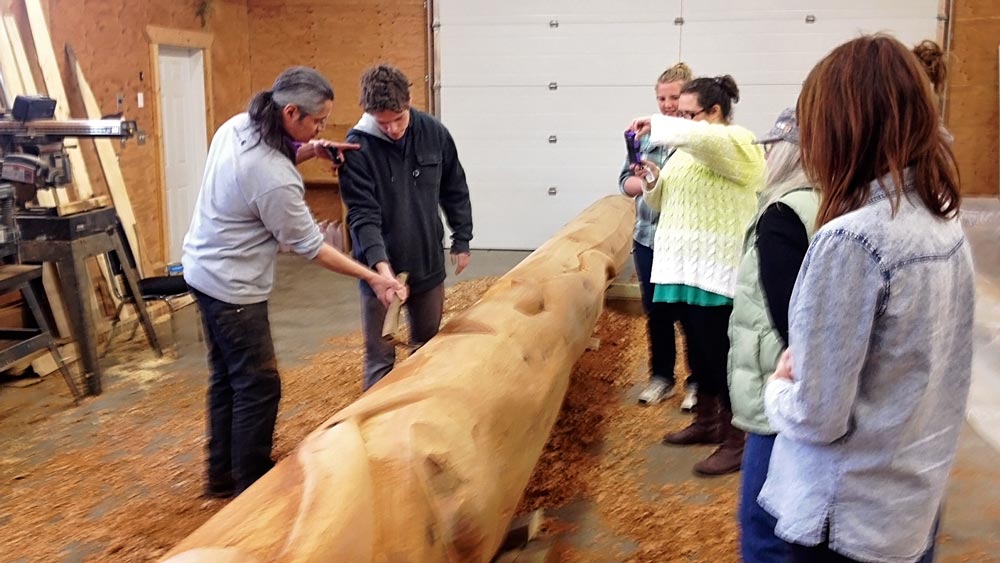NWCC students visit northwest First Nations and make lasting connections
The Cultural Heritage of the Skeena and Bulkley Valley field school, led by Crossroads CRM director Rick Budhwa for Northwest Community College, incorporates First Nations history with cultural resource management over three weeks each spring. The course provides a history of First Nations and the influences upon them going back 10,000 years, through European contact up until present day. It discusses influences of colonialism and understanding First Nations’ role in the overall history of B.C. Australian journalist Alicia Bridges audited the course and describes her experience.
••••

As an Australian living in Smithers, B.C. and a newcomer to Canada, I was invited by Crossroads CRM to attend Northwest Community College’s Cultural Heritage of the Skeena and Bulkley Valley course last month as a spectator. I jumped at the opportunity to expand my limited knowledge of B.C. and First Nations history. Having developed a strong understanding of the issues faced by Australian Aboriginal people through my work as a journalist, I was also interested in the similarities and differences between my home country and Canada.
I attended the anthropology component of the combined history and anthropology course run by NWCC as part of its field school program. The course summarized First Nations history, from the migration of humans to North America to the challenges facing Aboriginal people in Canada today. I was also able to join the students on a field trip to Hagwilget Canyon and the ‘Ksan Historical Village at Gitanmaax, one of three field trips to reserves.
On the first day, in a classroom at Northwest Community College in Smithers, students brainstormed words relating to the First Nations of British Columbia. Their lecturer, Crossroads CRM principal and anthropologist Rick Budhwa, scribbled suggestions including “Aboriginal,” “band” and “reserve” on a white board.
Soon the board was filled with words and phrases and Budhwa ran through their true definitions and correct usage. However, not all of the terms had a clear-cut explanation and there were questions from the class.
Was it ever correct to refer to a First Nations group as an Indian band? If the definition of the word “native” was technically correct, why did it have negative connotations? And, if it could be considered derogatory, why did some First Nations still use the word themselves?
In addition to providing definitions of words frequently used to talk about Canada’s First Nations, it was a lesson in respect and etiquette. The variation in how some terms were perceived and used by Aboriginal groups highlighted the importance of understanding that each First Nation was unique. Budhwa also told the class that it takes time and respect to establish strong relationships.
The students reaped the rewards of Crossroads’ relationships during the field trips, as they were able to visit significant cultural sites and meet prominent First Nations individuals, more as guests than as tourists.
In Hagwilget Village, we were invited to help carve a totem pole being made in honour of recently deceased Chief Alfred Joseph. Councillor Peggy Underhill volunteered a story about her people’s clash with the government over Hagwilget Canyon. As we stood near a sacred burial ground at the verge of the canyon, Jody Joseph shared with us his memories from the day it was disturbed by BC Hydro.
The willingness of First Nations people to share their personal stories left a lasting impression on the students. Toby Walsh, a former teacher and Smithers resident, said he learned more during the course than in the 42 years he has lived in the area. He had not expected humour to translate so readily between Western and First Nations cultures.
“Humour is a peculiar thing,” he said. “It doesn’t always make the jump successfully between cultures but when it does, an important connection has been made.”
For Brittany Barendregt, taking the course was a requirement for her nursing studies. She was taken aback by the openness of the people she met and their willingness to share their culture with strangers.
“It amazes me how they totally opened up and let us ask a ton of questions and just be curious and nosy,” Barendregt said. “They work hard, but they also take time to learn their history and have massive feasts and just laugh and laugh.
“Seeing all this and learning about their beliefs will really help me in my nursing career to be more sensitive and connect with them easier.”
For me, the course provided personal, local insights I could never have gained from reading or researching. Budhwa was able to demonstrate the broader issues affecting Aboriginal people in B.C. with examples involving local people and places. Importantly, the course provided a rare opportunity to hear the history of B.C. as told by First Nations people.
Budhwa said the students were surprised and comforted by the existing relationships he had with the communities they visited.
“Long-held relationships established through Crossroads allowed them to just step into the community as guests,” he said. “They have already got someone who has an intimate relationship with (the First Nations) and they benefit from that. The interaction was a different interaction.”
Budhwa hopes more organizations, particularly government departments, will start to recognize the value of a First Nations learning experience that doesn’t come from a textbook and he believes the class’s benefits will flow into the community through his students.
“Someone like a nursing student may not become an anthropologist, but they work with people, so I couldn’t think of anything more important than to learn more about the people that they work with,” he said. “They’ll be better nurses and better practitioners.”
Now that the students have initiated relationships with First Nations people in the area, he hopes they will use the tools they learned in class to help them grow.
“I hope they take away what it takes to build, maintain and strengthen a relationship with First Nations, whether it’s a person or a group of people, and understand the simplicity of it as well as the importance of it,” he said. “Really, it’s about spending time and it’s about being present with these folks if we want a meaningful relationship with them.”


